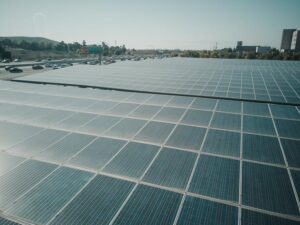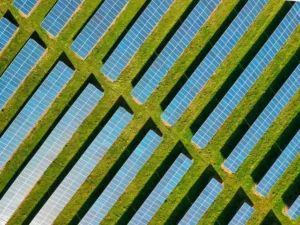
Once you’ve decided to invest in solar panels, then now comes the crucial decision of choosing the right materials to ensure maximum efficiency. You might have heard of Maxeon’s high energy efficiency or Canadian Solar’s DIY-friendly approach, but what about the other top picks for super-efficient solar panel materials?
Each material comes with its unique benefits, from excellent durability to being best suited for specific climates. But what are the top 7 picks, and how do they stack up against each other?
Stay tuned to uncover the best options for your solar panel needs.
Key Takeaways
- Silicon solar cells are the industry standard for solar technology, known for their reliability, high efficiency, and durability.
- Thin-film solar cells offer a lightweight and versatile alternative, with easier installation and better performance in low-light conditions.
- Perovskite solar cells show promise for higher efficiency and lower production costs compared to silicon cells, with a wide absorption spectrum and suitability for curved surfaces and portable devices.
- Embracing a circular solar economy, through recycling and reusing solar panel materials, reduces the environmental footprint of the solar industry and maximizes the value of components.
Overview Of Super-Efficient Solar Panel Materials
The most efficient solar panels often utilize crystalline silicon, a prevalent material. Notably, monocrystalline panels, like those from LG and Maxeon, achieve high efficiency, around 22.30% and 22.80%, respectively.
Cutting-edge advancements involve perovskite tandem cells, combining traditional silicon with perovskites, showcasing promise with efficiency exceeding 33% in labs. Companies like Oxford PV aim to deliver commercial-size perovskite tandem cells with an efficiency of 28.6%.
The efficiency race extends beyond silicon, with the most efficient solar cells using N-type monocrystalline silicon or variations like heterojunction (HJT) and TOPcon cells. Top performers include Aiko Solar’s Black Hole series (23.8% efficiency) and Recom Tech’s Black Tiger (23.6% efficiency).
In addition to silicon, solar innovations encompass diverse technologies, from thin-film panels to perovskite solar cells, contributing to increased efficiency and versatility.
Understanding solar panel efficiency is crucial, as it directly impacts energy output. Higher efficiency not only accelerates the payback period but also optimizes space utilization, translating to increased return on investment.
Efficiency improvements in solar panels, coupled with technological innovations, are pivotal in advancing clean energy adoption, making solar power an increasingly attractive and sustainable option for electricity generation.
Silicon Solar Cells: The Industry Standard
If you’re wondering why silicon solar cells are considered the industry standard, it’s because of their widespread use in solar panels and their reputation for reliability, high efficiency, and long-term durability. These cells have a single crystal structure that efficiently converts sunlight into electricity, making them a popular choice for both residential and commercial solar panel installations.
One of the reasons for their widespread use is the continuous advancements in silicon technology, which have led to increased efficiency and reduced production costs. Silicon solar cells are often the preferred choice for those seeking a well-established and proven solar technology.
However, despite their dominance in the market, emerging alternatives to silicon, such as perovskite and organic solar cells, are gaining attention due to their potential for higher efficiency and lower manufacturing costs. While silicon solar cells continue to be the go-to option, the industry is closely watching the development of these alternative technologies.
As advancements in materials science continue, it will be interesting to see how these emerging alternatives may impact the future of solar panel technology.
Thin-Film Solar Cells: Lightweight and Versatile
Let’s talk about their efficiency and flexibility, and why these qualities make them stand out in the realm of solar panel materials.
Advantages of Thin-Film
Thin-film solar cells offer a lightweight and versatile alternative to traditional solar panels, making them easier to install and suitable for a wide range of applications. Their advantages are evident in the potential applications they offer.

These cells can be seamlessly integrated into various surfaces such as roofs, windows, and even clothing, providing flexibility in design and placement. Additionally, thin-film solar cells exhibit a higher tolerance to shading and perform better in low-light conditions compared to conventional solar panels. They also have a faster energy payback period and require less energy to produce, making them more environmentally friendly.
Furthermore, the manufacturing process of thin-film solar cells uses less material, potentially leading to cost-effective and affordable options for consumers. These advantages position thin-film solar cells as a promising and efficient choice for solar energy harnessing.
Efficiency and Flexibility
With their lightweight and versatile nature, thin-film solar cells offer unparalleled efficiency and flexibility in harnessing solar energy. These cells can be seamlessly integrated into various surfaces, including unconventional and curved structures, making them ideal for diverse applications. Their lightweight design not only enables easy installation but also makes them suitable for areas where traditional solar panels may not be feasible.
Thin-film solar cells excel in low light conditions, providing a reliable option for different environments. They are commonly used in portable and off-grid solar applications due to their flexibility and ease of transport. The table below highlights the advantages of flexible solar panels and the applications of efficient solar panel materials.
|
Advantages of Flexible Solar Panels
|
Applications of Efficient Solar Panel Materials
|
|---|---|
|
Lightweight and versatile
|
Diverse surface integration
|
|
Ideal for unconventional structures
|
Portable and off-grid applications
|
|
Excellent performance in low light
|
Reliable option for various environments
|
Perovskite Solar Cells: The Next Generation
Perovskite solar cells represent a promising advancement in solar panel technology due to their potential for higher efficiency and lower production costs compared to traditional silicon solar cells. These cells have a wide absorption spectrum, capturing more sunlight for energy production. Additionally, their flexibility and lightweight nature make them suitable for a variety of applications, including curved surfaces and portable devices.
Ongoing research aims to address stability and durability issues to make perovskite solar cells commercially viable for widespread use. This is crucial for their commercialization and integration into the mainstream solar energy market. With their potential to revolutionize solar energy, perovskite solar cells hold promise for a more sustainable and efficient future.
Bio-Based Solar Cells: Sustainable Innovations
Are you interested in the latest sustainable innovations in solar panel technology? Bio-based solar cells, made from organic polymers or perovskite materials derived from natural sources, are paving the way for a greener and more eco-friendly approach to energy production. These cells offer a renewable alternative to traditional silicon-based solar cells, significantly reducing the environmental impact of solar panel production.
By harnessing renewable energy sources, bio-based solar cells provide an environmentally friendly solution to energy needs. The environmental benefits are substantial, as the use of organic or bio-based materials in solar cell production contributes to the development of a more sustainable and eco-friendly energy infrastructure.
Research and innovation in bio-based solar cells aim to make solar energy production more efficient and environmentally friendly. Here’s a breakdown of the environmental benefits and renewable energy sources associated with bio-based solar cells:
|
Environmental Benefits
|
Renewable Energy Sources
|
Potential for High Efficiency
|
|---|---|---|
|
Reduced ecological footprint
|
Harnesses renewable energy
|
High-efficiency levels
|
|
Sustainable and eco-friendly
|
Organic and bio-based materials
|
Green energy solution
|
With their potential for high efficiency and minimal ecological footprint, bio-based solar cells are at the forefront of sustainable innovations in solar panel technology.
Organic Photovoltaics: Flexible Solar Solutions
Organic photovoltaics offer a flexible and sustainable option for a wide range of energy needs. These solar panels aren’t only lightweight but can also be shaped, making them ideal for curved or irregular surfaces.

The manufacturing process of organic photovoltaics involves cost-effective techniques such as low-cost printing, making them an affordable option. Furthermore, these solar panels have the potential for high efficiency and can perform well in low-light conditions, expanding their applications to various environments.
Additionally, organic photovoltaics are environmentally friendly and can be recycled, aligning with the growing emphasis on sustainable energy solutions.
Whether for portable electronics, building-integrated photovoltaics, or off-grid power generation, the adaptability and low-cost manufacturing process of organic photovoltaics make them a compelling choice for a wide range of applications.
Recycling and Reusing: Towards a Circular Solar Economy
Recycling and reusing materials in the solar industry is pivotal for nurturing a circular solar economy. Embracing a circular economy benefits not only the environment but also the solar industry itself. By recycling solar panels, valuable materials like silicon, glass, aluminium, and copper can be reclaimed for reuse. This not only reduces the need for new raw materials but also minimizes waste and environmental impact.
Implementing effective recycling and reusing processes can significantly reduce the environmental footprint of the solar industry. Moreover, a circular solar economy maximizes the value of solar panel components, contributing to a more sustainable and efficient industry overall. Collaboration among manufacturers, recyclers, and policymakers is essential for creating a sustainable and circular solar economy. This collaborative effort can lead to innovative solutions for recycling and reusing solar materials, further reducing the industry’s impact on the environment.
High-Efficiency Solar Panel Materials
When seeking high-efficiency solar panel materials, it’s important to consider the energy efficiency ratings offered by various manufacturers. Among the top picks for high-efficiency solar panels are:
- Maxeon (formerly SunPower) offers the most energy-efficient solar panels with an efficiency rate of 20%–22.8%.
- Canadian Solar provides the most DIY-friendly solar panels with an efficiency rate of 18.7%–22.8%.
- REC offers the best durability with solar panels boasting an efficiency rate of 19.1%–22.3%.
- Panasonic’s solar panels are best suited for hot climates, with an efficiency rate of 21.2%–22.2%.
High-efficiency solar panels offer significant benefits for residential use. They can generate more electricity in a smaller space, making them ideal for homes with limited roof space. Additionally, high-efficiency solar panels contribute to reducing carbon emissions by producing more energy with the same amount of sunlight. This means that households using high-efficiency panels can significantly lessen their environmental impact.
Therefore, when choosing solar panels for residential use, opting for high-efficiency materials can lead to both economic and environmental advantages.
Frequently Asked Questions
What Is the Most Efficient Solar Panel Material?
The most efficient solar panel material depends on various factors. Crystal silicon is widely used for its reliability, while thin-film technology offers flexibility. Perovskite and organic materials show promise in achieving high efficiency.
How Do You Make Solar Panels 100% Efficient?
To maximize energy output and improve the performance of solar panels, focus on using high-quality materials, optimizing the manufacturing process, and staying updated on research. While reaching 100% efficiency is challenging, current technology can already meet most household energy needs.
Which Solar Panel Has 20% Efficiency?
You can find solar panels with 20% efficiency, like those offered by Maxeon (formerly SunPower). Their advanced technology and high efficiency make them a cost-effective choice, despite being more expensive than other options.
What Is the Best Solar Material?
When choosing the best solar material, consider the latest advancements in solar technology and innovation. Look for solar panels with high efficiency and durability, suited for your specific climate. Evaluate the long-term performance guarantee for a reliable investment.
Conclusion
When it comes to choosing materials for efficient solar panels, silicon solar cells are reliable and durable. However, alternatives like perovskite and organic solar cells show promise for higher efficiency and lower costs. Thin-film solar cells are lightweight and perform well in low light. Perovskite cells are suitable for curved surfaces and portable devices.
Bio-based solar cells are sustainable and eco-friendly. Maxeon offers high-efficiency panels, Canadian Solar is DIY-friendly, REC is durable, and Panasonic’s panels are best for hot climates. Consider these options for a sustainable future.



